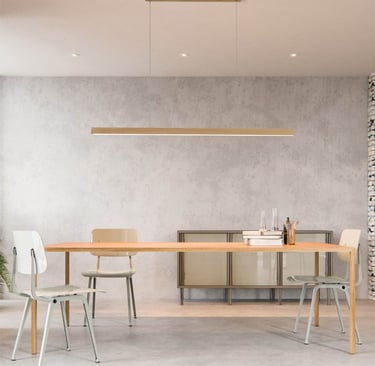Linear Wooden Pendant Lights Add Modern Feeling to Interior Space
6/8/20234 min read


In the field of contemporary interior design, the art of lighting goes beyond mere illumination, becoming an interpreter of spatial aesthetics and individual style.
Linear wooden pendant lights, as dazzling stars in the design world, with their unique shapes and the warmth of natural wood, skillfully blend fashion and warmth in modern homes, becoming an indispensable symbol of style.
This blog aims to delve into how linear wooden pendant lights elegantly integrate into modern design trends, while also sharing a series of practical guidelines to help you skillfully use this design element, illuminating the boundless possibilities of your living space.
How Wooden Linear Lights Gracefully Integrate into Modern Design Trends
The Design Aesthetics of Linear Wooden Chandeliers
In modern home design, simplicity without compromising style is one of the core concepts. Linear wooden chandeliers, with their clean lines and natural wood grain, seamlessly incorporate this design philosophy.
The warm texture of wood contrasts with the cold, hard materials such as metal and glass commonly found in modern designs, bringing balance and harmony to interior spaces.
Selection and Combination of Materials
The choice of wood material is crucial to the overall effect of the chandelier. Different types of wood, such as oak, walnut, cherry, each have their unique colors and textures, which can be selected based on the overall style and color scheme of the interior.
The light-colored wood can bring brightness and an open feel to a space, while dark wood can create a sense of stability and elegance.
Characteristics of Linear
Design Linear design emphasizes smooth lines and simple shapes. Linear wooden chandeliers often feature straight lines or soft curves, which not only guide the eye but also enhance the sense of depth in a space.
Creation of Lighting
Effects The lighting effect is also an essential part of its design. By adjusting the height, angle, and intensity of the chandelier, different lighting effects can be created.
For example, soft lighting can create a warm and comfortable atmosphere, while bright lighting is suitable for work areas where concentration is required.
Consideration of Spatial Layout
In modern home design, the rationality of spatial layout is also crucial. Linear wooden chandeliers can serve as focal points, guiding people's gaze and movement.
In the living room, a chandelier can be hung in the center to become the visual focal point; in the dining room, the chandelier can be suspended above the dining table to provide lighting and decoration for meals.
Possibilities for Personalization and Customization
Modern home design emphasizes personalization and customization. Linear wooden chandeliers can be tailored to meet the client's needs, with adjustments possible in size, shape, and color to fit the specific requirements of the interior and personal preferences.
This customization service enhances the uniqueness of home design. If you require custom wooden lighting, please contact us.
Coordination with Other Decorative Elements
Linear wooden chandeliers should not only be aesthetically pleasing on their own but also coordinate with other decorative elements in the interior space. For instance, the wood grain of the chandelier can echo the wooden elements in furniture, flooring, or walls, creating a unified and harmonious visual effect.
Fusion of Modern and Traditional In modern home design, the inclusion of traditional elements can add depth and cultural heritage to a space. Linear wooden chandeliers can draw on the exquisite craftsmanship of traditional woodwork, combining traditional aesthetics with modern design to create an interior that is both contemporary and retains a touch of traditional charm.
Unique Charm in Different Scenarios
Flexible Application: From Single Spaces to Multifunctional Areas
As the trend for open living concepts gains popularity, linear wooden chandeliers have become a versatile option, bridging various areas such as living rooms, dining areas, and even workspaces.
Their well-designed lighting layouts not only define the function of each space but also maintain the flow and coherence of the entire space, creating a visually unified and harmonious environment.
For example, in an open kitchen-dining area, the chandelier not only provides ample lighting for food preparation but also casts a soft glow over the dining table, creating a cozy atmosphere for meals.
Innovative Design: The Fusion of Smart Lighting and Wooden Elements In today's rapidly evolving technology landscape, smart home technology has also breathed new life into linear wooden chandeliers.
By integrating smart control features, users can easily adjust the brightness, color temperature, and even link the chandelier with other smart devices in the home, automatically changing the lighting mode according to time, mood, or activity needs.
This intersection of tradition and future not only retains the warmth of wood but also gives the lighting a more intelligent and personalized experience.
Cultural and Emotional Transmission
Every piece of wood carries the mark of nature and the story of time, and as part of interior decoration, linear wooden chandeliers are not just bearers of light but also repositories of emotion and memory.
Incorporating specific cultural elements or family symbols into the design, such as using wood with local characteristics or carving traditional patterns, can turn the chandelier into a medium for passing on culture and connecting the past with the present, adding a profound meaning and value to the living space.
Design Thinking from a Sustainability Perspective
On the basis of pursuing aesthetics and functionality, the design of linear wooden chandeliers should actively respond to the needs of environmental protection.
This is not only reflected in the selection of sustainably grown wood to reduce environmental burden, but also in energy-saving and emission-reduction during the production process, as well as in encouraging the recycling and reuse of products after use.
By sharing these concepts and practices of eco-friendly design, more people are encouraged to realize that even the choice of lighting in daily life can contribute to the sustainable future of the Earth.
